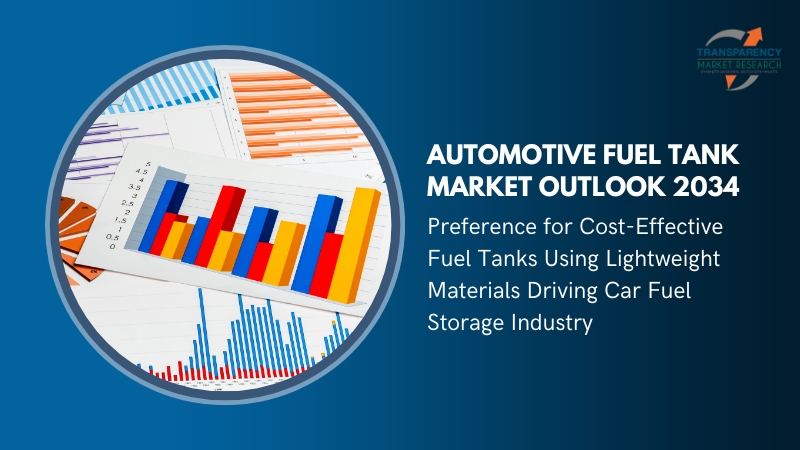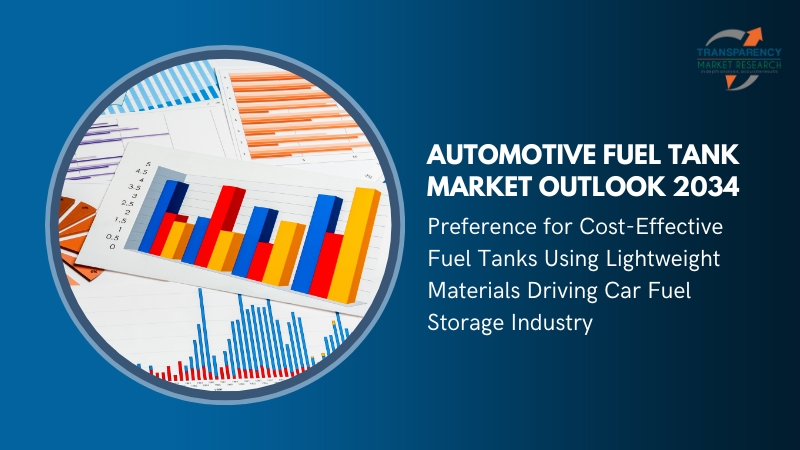Automotive Fuel Tank Market to Hit USD 25.3 Billion by 2034, Driven by Rising Vehicle Production and Technological Innovations | TMR

Wilmington, Delaware, United States, Transparency Market Research Inc.-, Dec. 05, 2024 (GLOBE NEWSWIRE) -- The global automotive fuel tank market (自動車燃料タンク市場) was valued at USD 16.7 billion in 2023 and is projected to expand at a CAGR of 3.9%, reaching USD 25.3 billion by 2034. This growth is driven by the increasing demand for passenger and commercial vehicles, stringent emissions regulations, and advancements in fuel tank technologies.
Fuel tanks, a critical component of any vehicle, are evolving to incorporate lightweight materials such as plastic composites and aluminum to improve fuel efficiency and reduce carbon footprints. The shift toward alternative fuel vehicles is also influencing innovations in fuel tank design, ensuring compatibility with biofuels, compressed natural gas (CNG), and hybrid vehicles.
Request a PDF Sample - https://www.transparencymarketresearch.com/sample/sample.php?flag=S&rep_id=15035

Key Drivers of Market Growth
1. Rising Vehicle Production and Urbanization
The increasing production of vehicles, especially in emerging economies, is a significant driver for the automotive fuel tank market. Rapid urbanization and rising disposable incomes in Asia Pacific and Latin America are boosting car ownership, thus propelling market demand.
2. Focus on Lightweight and High-Durability Materials
Manufacturers are investing in lightweight and durable materials such as high-density polyethylene (HDPE) and advanced aluminum alloys to meet fuel efficiency standards and improve vehicle performance. These materials offer higher resistance to corrosion and lower production costs, making them popular choices for modern automotive fuel tanks.
3. Stringent Environmental Regulations
Global regulatory frameworks, including those by the European Union and the Environmental Protection Agency (EPA) in the U.S., are pushing automakers to adopt technologies that reduce emissions. Modern fuel tanks designed to minimize vapor emissions and ensure better compatibility with alternative fuels are becoming a critical focus area.
4. Emergence of Electric and Hybrid Vehicles
Although electric vehicles (EVs) are gaining traction, hybrid electric vehicles (HEVs) still rely on fuel tanks. Manufacturers are adapting fuel tank designs to align with the hybrid vehicle architecture, ensuring the continued relevance of the market in an increasingly electrified automotive landscape.
For tailored insights into the automotive fuel tank market, request a custom report today to stay ahead in this dynamic industry: https://www.transparencymarketresearch.com/sample/sample.php?flag=S&rep_id=15035
Analysis of Key Players
The automotive fuel tank market is highly competitive, with several global and regional players focusing on product innovation and strategic partnerships to enhance their market presence.
Leading companies include:
- Plastic Omnium: A pioneer in lightweight and environmentally friendly fuel tanks, catering to global automakers.
- Kautex Textron GmbH & Co. KG: Known for its advanced blow-molded plastic fuel tanks with integrated sensors for modern vehicles.
- YAPP Automotive Systems: A leader in fuel tank solutions for the growing Asian automotive market.
- Magna International Inc.: Focused on innovation in multi-layer fuel tank technology to meet strict emissions standards.
- TI Fluid Systems: Specializes in hybrid and alternative fuel-compatible tanks, reflecting the shift toward sustainable mobility.
These companies are investing in R&D to develop solutions that align with the automotive industry's shift toward electrification and alternative fuels while ensuring durability and cost efficiency.
Market Segmentation
The automotive fuel tank market is segmented based on material, capacity, vehicle type, and regions.
By Material:
By Capacity:
- Less than 45 liters
- 45–70 liters
- More than 70 liters
By Vehicle Type:
- Passenger Cars
- Light Commercial Vehicles (LCVs)
- Heavy Commercial Vehicles (HCVs)
By Regions:
- North America
- Europe
- Asia Pacific
- Latin America
- Middle East & Africa
Regional Insights
Asia Pacific: The Growth Hub
Asia Pacific dominates the automotive fuel tank market due to high vehicle production and growing demand for passenger and commercial vehicles in countries like China, India, and Japan. The region benefits from its robust automotive supply chain and a rising focus on lightweight materials to meet stringent emission norms.
North America: Innovation in Fuel Efficiency
North America, led by the U.S., is witnessing steady growth due to advanced automotive manufacturing processes and a strong emphasis on reducing emissions. The region's regulatory frameworks, such as CAFE standards, drive innovations in fuel tank design.
Europe: Stringent Environmental Standards
Europe's automotive sector is characterized by strict emission norms, encouraging the adoption of lightweight and eco-friendly materials in fuel tanks. The push for alternative fuel vehicles is also a significant growth driver in this region.
Latin America and the Middle East & Africa: Emerging Markets
In Latin America and the Middle East & Africa, increasing vehicle production and rising demand for durable automotive components are supporting market growth. Brazil and South Africa are notable contributors in these regions.
Emerging Trends in the Automotive Fuel Tank Market
1. Shift Toward Multi-Layer Fuel Tanks
Multi-layer fuel tanks that prevent vapor emissions and ensure compliance with environmental standards are becoming a preferred choice. These tanks also enhance fuel efficiency, making them ideal for modern vehicles.
2. Growth of Alternative Fuel-Compatible Tanks
As the world moves toward sustainable mobility, the demand for tanks compatible with biofuels, hydrogen, and CNG is rising. Manufacturers are focusing on creating versatile fuel tanks to cater to this growing segment.
3. Integration of Advanced Sensors
The incorporation of advanced sensor technologies to monitor fuel levels, temperature, and pressure is improving the functionality and safety of automotive fuel tanks.
4. Recycling and Sustainability Initiatives
Manufacturers are adopting recycling initiatives to produce fuel tanks from eco-friendly materials, aligning with global sustainability goals.
Purchase now to access comprehensive insights and forecasts for the automotive fuel tank market: https://www.transparencymarketresearch.com/checkout.php?rep_id=15035<ype=S
Future Outlook
The automotive fuel tank market is poised for steady growth as manufacturers continue to innovate and adapt to evolving consumer preferences and regulatory requirements. The emphasis on lightweight materials, alternative fuel compatibility, and advanced technology integration will shape the market's trajectory in the coming decade.
With the growing global focus on and fuel efficiency, the automotive fuel tank market is set to remain a critical component of the automotive value chain, ensuring its relevance and expansion well into 2034.
More Trending Reports by Transparency Market Research:
- Commercial Vehicle Telematics Market (商用車テレマティクス市場) - Rising Demand for Fleet Management and Regulatory Compliance Boosts Share in Market
- Automotive Catalysts Market (Marché des Catalyseurs Automobiles) - Automotive Catalysts Market size is expected to reach a value of US$ 155.3 Bn by the end of 2034.
About Transparency Market Research
Transparency Market Research, a global market research company registered at Wilmington, Delaware, United States, provides custom research and consulting services. Our exclusive blend of quantitative forecasting and trends analysis provides forward-looking insights for thousands of decision makers. Our experienced team of Analysts, Researchers, and Consultants use proprietary data sources and various tools & techniques to gather and analyses information.
Our data repository is continuously updated and revised by a team of research experts, so that it always reflects the latest trends and information. With a broad research and analysis capability, Transparency Market Research employs rigorous primary and secondary research techniques in developing distinctive data sets and research material for business reports.
Contact:
Transparency Market Research Inc.
CORPORATE HEADQUARTER DOWNTOWN,
1000 N. West Street,
Suite 1200, Wilmington, Delaware 19801 USA
Tel: +1-518-618-1030
USA – Canada Toll Free: 866-552-3453
Website: https://www.transparencymarketresearch.com
Email: sales@transparencymarketresearch.com
Follow Us: LinkedIn| Twitter| Blog | YouTube

© 2024 Benzinga.com. Benzinga does not provide investment advice. All rights reserved.
Breaking news
See all







